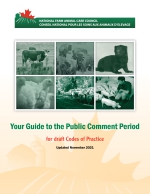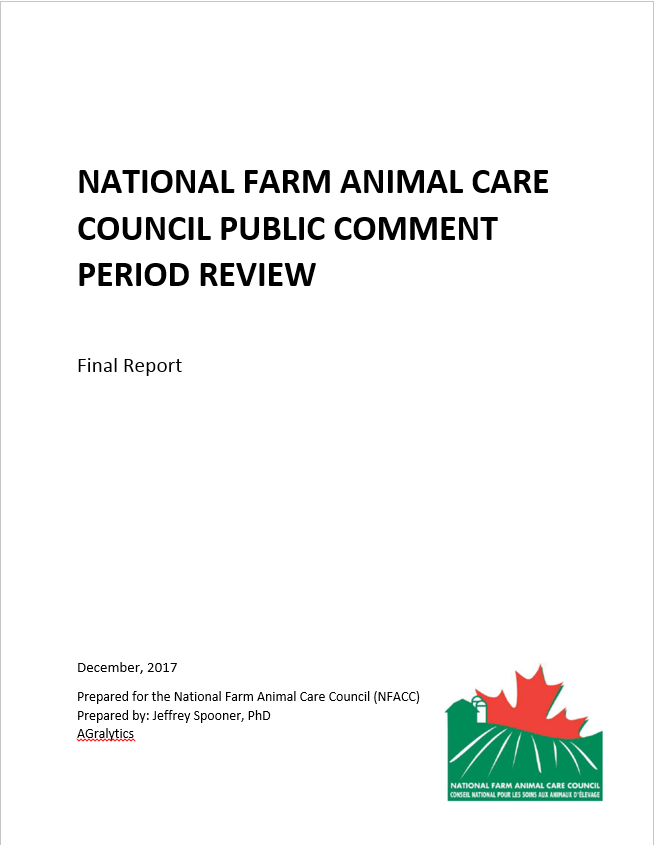Codes Of Practice
Developed through NFACC
- Bison
- Dairy Cattle
- Farmed Fox
- Farmed Mink
- Farmed Salmonids
- Goats
- Pullets and Laying Hens
- Rabbits
- Veal Cattle
Under Revision
Archived Recommended Codes of Practice
Code Development Process
Watch our short video - "The People Behind the Public Comment Period"
Maintaining the Integrity of Public Comment Periods
NFACC is continually aiming higher to enhance its already robust processes. An internal review of the Public Comment Period process has been conducted to further enhance how feedback is invited, received, and incorporated into the Code development process. Read the final report, National Farm Animal Care Council Public Comment Period Review.
Your Guide to the Public Comment Period
 Public comments fuel Canada’s farm animal care progress
Public comments fuel Canada’s farm animal care progress- ‘The Codes’ 101
- Listening to Canadian voices
- Protecting your privacy
- The Public Comment Period process
- By the numbers
- Road to the Codes
- Working toward continual improvement
Building consensus through a multi-stakeholder approach is the backbone of the Code development process and the Public Comment Period is a vital component. Participation is encouraged because this ultimately supports a robust process and helps make the Codes the best they can be.
Public comments fuel Canada’s farm animal care progress
Viewpoints from a broad range of stakeholders play an important role in the development of Codes of Practice for the care and handling of farm animals
Farm animal care is a critically important part of livestock production. Everyone from farmers to consumers has a valuable role to play – and an important voice to add to the conversation – as new knowledge, opportunities for innovation and the expectations of the marketplace continue to evolve.
This is why public feedback is an essential part of Canada’s process for developing Codes of Practice for the care and handling of farm animals. A well-structured and robust Public Comment Period is crucial to support the quality and success of these standard-setting documents.
The opportunity to participate in the Public Comment Period for each Code is open to all who have an interest in supporting Canada as a leader in farm animal care as part of a well-managed and competitive food system. Your feedback plays a vital role in providing a check and balance to the Code development process and in determining the direction set in the final document.
The Guide to the Public Comment Period provides an overview of this indispensable component of the process and how it supports Code development.
‘The Codes’ 101
Setting the bar for Canada’s approach to farm animal care
Canada has established Codes of Practice for the care and handling of farm animals that serve as the national understanding of animal care requirements and recommended practices.
Codes are targeted for particular livestock, fish and poultry species, and collectively these documents cover all the major species raised on farms across the country. There has been a major effort undertaken to update these Codes of Practice to better reflect today’s knowledge, capacities, and expectations.
This process has been led and coordinated by the National Farm Animal Care Council (NFACC), which represents and involves a broad range of stakeholder groups including farm animal industries, animal welfare organizations, retail and food service, the veterinary community, government and other allied groups with an interest in farm animal care. Learn more about the Codes of Practice and NFACC at www.nfacc.ca/codes-of-practice.
Listening to Canadian voices
All viewpoints expressed are heard and play a role in Canada’s direction
Is my viewpoint heard and do I have an influence?
This is arguably the most important question for anyone who chooses to participate in the Public Comment Period. The answer is an emphatic “Yes”.
Code Managers are charged with collating all the feedback from the Public Comment Period before organizing and providing this to the Committee members they facilitate.
All the comments received are organized to ensure that they can receive appropriate consideration. This often involves painstaking work to categorize and sub-categorize the comments so they can be accessed and reviewed by the committee as efficiently as possible.
A common reflection from Committee members is how pleased they are with the diversity of people who provide input and how this enhances the final Code. Committee members take great care and time to consider all the viewpoints presented.
As of 2021 What We Heard and How We Addressed It reports are developed to provide insights on how the feedback from the comment period informed the final version of a Code of Practice.
Protecting your privacy
Measures are in place to protect the privacy of both individuals and organizations who submit information as part of the Public Comment Period.
A name and email address must be entered to ensure the integrity of the information and provide a means for contacting an individual if there are questions about their submission. However, names and email addresses are kept in confidence; they are not provided to the Code Committee or shared publicly.
When official submissions are made on behalf of an organization, the name of the organization is identified along with the information submitted when it is provided to the Code Committee. This recognizes the particular expertise that an organization may have, along with the rigorous process that some organizations would have undertaken to arrive at a collective submission amongst their membership. However, this information – including names of organizations and the feedback they provided – is not made public by NFACC.
The Public Comment Period process
Supporting strong Codes for a sustainable future
The pathway toward a new Code of Practice includes several important milestones (See “Road to the Codes”), with the Public Comment Period playing a crucial role in ensuring a workable and effective approach before each new Code is finalized and implemented.
Here’s a breakdown of the key steps related to the Public Comment Period:
Step 1: Dates are determined
Most of the Code process centers on the various stakeholders who make up the Code Committee working together to develop a draft document. Once this critical achievement is realized, the focus turns to organizing and delivering the Public Comment Period.
To support a process that is both manageable and timely, the length of the Public Comment Period is set at 60 days for each Code. The aim is for this period to begin soon after a draft Code is developed, to support an efficient Code process.
Step 2: Communication is delivered
Communication is critical at every stage of Code development to keep stakeholders informed and support good process. This includes a multi-component communication effort to support awareness of the Public Comment Period and encourage participation, led by a joint announcement from NFACC and the industry group that initiated the Code development or update process.
Step 3: Comments are received
Once the Public Comment Period begins, those who wish to participate can review the draft Code of Practice and submit their comments.
The draft Code is made available on the NFACC website, at www.nfacc.ca, and a platform is provided for submitting comments. Typically, industry organizations such as producer associations, as well as organizations representing other interest groups, provide links to this online system through their own websites and some also offer assistance with submitting comments. This approach allows for a consistent approach across different Codes. It also allows effective and secure collection and storage of comments in a consistent platform. Overall, it supports the quality of the process and the fulsome consideration of the comments made.
Step 4: Feedback is organized and provided to Committee
The comments received are then collected by the Code Manager of the Code Committee. The Code Manager is charged with organizing and providing this information to the Committee in a manner that is most effective. Code Managers will organize information in a logical format, based on considerations such as the volume of comments and what makes sense for the Committee members they are supporting.
Effort is made to provide the information in a timely fashion following the completion of the Public Comment Period, with the specific timing varying somewhat depending largely on the volume of information the Code Manager is required to organize.
Step 5: Committee reviews comments and determines what changes are needed
The comments are provided to Committee members in a manner that allows each member to review on their own before discussing as a full Committee.
A date is also determined for a full Committee meeting to discuss the feedback received and determine any changes needed to the Code as a result. The length and number of meetings required depends on how quickly consensus is reached on each of the issues raised by the Public Comment Period feedback. Typically, one or two multi-day sessions are required. However, some Codes have required additional meetings and effort to achieve consensus.
Once consensus is reached, arrangements are made to revise and finalize the Code as needed before the Code process is fully completed.
By the numbers
Multiple Codes of Practice have been completed for different species in recent years.
Each submission to a Public Comment Period from an individual or organization may contain just a few comments on one or two topic areas or dozens of comments across all topic areas of a Code. Here’s a rundown of the approximate number of submissions received for several Codes during their respective Public Comment Period.
New or updated Codes:
- Dairy cattle (2009) – approximately 120
- Farmed mink (2012) – just under 200
- Farmed fox (2012) – just over 200
- Equine (2012-2013) – about 600
- Beef cattle (2013) – approximately 400
- Sheep (2013) – about 200
- Pigs (2013) – over 4,700
- Rabbits (2017) - 482
- Veal Cattle (2016-2017) - 1000
- Bison (2016-2017) - 110
- Pullets and Laying Hens (2016) - 1900
- Hatching Eggs, Breeders, Chickens, and Turkeys (2015) – 904
- Farmed Salmonids (2020-2021) – 126
- Goats (2020-2021) – 321
Code Amendments
- Farmed Mink amendment (2020-2021) - 1186
- Pigs amendment (2020) - 1122
Road to the Codes
The development of Codes follow specific stages that are designed to make the process transparent, collaborative, science and consensus-based, and participative. A brief snapshot of the main components:
- Getting started. Industry group identifies need for Code revision and initiates the process with NFACC.
- Building the team. A Code Committee is formed based on Guiding Principles established by NFACC.
- Getting focused. Priority welfare issues are identified.
- Hearing ‘what the science says’. A team of leading scientists reviews the scientific literature for each priority welfare issue and develops a report for the committee.
- Working together to nail down a draft. The committee develops a draft Code using a consensus-based approach (which can take considerable time and effort) to guide decision-making.
- Facilitating public comments. NFACC makes the draft Code available for a 60-day Public Comment Period.
- Final considerations. Committee members consider and discuss all of the comments received and use this feedback as a basis to determine needed revisions before the Code is finalized.
- Delivering the goods. The committee submits its final Code to NFACC and industry prepares for implementation.
Get more detailed information on this process at www.nfacc.ca/code-development-process.
Working toward continual improvement
NFACC encourages feedback on the Public Comment Period and all aspects of Code development
A common thread throughout all aspects of the Code Process, including the Public Comment Period, is the principle of continual improvement. Canada has set a unique path that is based on pursuing this goal through the multi-stakeholder, consensus-based approach that is led and coordinated through NFACC.
Bringing different groups around the same table and working together to achieve consensus is no small feat and often represents a substantial challenge. However, this also represents as a major strength of Canada’s Code process. It supports the development of Codes that not only reinforce responsible care and good welfare for farm animals, but are workable and acceptable to a broad and diverse range of stakeholders.
Evolving to meet new expectations
The needs and discussion around farm animal care will continue to evolve and continue to be informed by new knowledge from science and opportunities identified for innovation.
Likewise, the process for Codes development, including the Public Comment Period, continues to be fine-tuned over time based on feedback from the stakeholders involved at all levels. For example, in 2017 NFACC commissioned a review of its Public Comment Period process. This internal review led to further enhancements of the Public Comment Period to support the integrity of the process, along with expanding opportunities for broader input.
Leadership in farm animal care means we must be committed to keep improving in everything we do. This principle is integral to NFACC as an organization. It is also important for Canada as it strives toward solutions that are good for animals, workable for farmers, and help us meet expectations in the marketplace.
Funded in part by the Government of Canada under the Canadian Agricultural Partnership’s AgriAssurance Program, a federal, provincial, territorial initiative.


